Tuesday night’s Leafs-Oilers game was a highly anticipated showcase of skill -- an all-star game with stakes -- and it did not disappoint. Oilers fans (and some Leafs fans) were raucous, Connor McDavid had some electric moments, Auston Matthews was all over the puck, and the pace was through the roof. The game’s MVP may have been the refs, who called just two penalties, giving us 56 minutes of 5-on-5 hockey. A late goal by the Oilers earned them a regulation victory, a just outcome considering who controlled the better half of the play.
With my role at Sportsnet generally being NHL coverage, but with an extra focus on the Leafs (given the theme of my radio show), I’ll come at an assessment of the game – and its relation to the big picture – from Toronto's angle.
They put themselves in a good spot – tied at two on the road with a few minutes to go against one of the league’s best teams – but found a way to let a fourth straight game slip away.
I used to do a lot of “Systems Analyst” posts, most of which picked a single moment and broke down what happened. Today, I was hoping to touch on some big picture Leafs issues, and one play gives me the perfect excuse to do that: the Oilers' game tying goal.
As of Wednesday, the Leafs are who people have believed them to be in previous seasons: an offensive threat that doesn’t defend well.
They’ve got tons of upside – elite offensive players who can break open a game at any minute – and plenty of downside, including a D-core that, past Morgan Rielly and generously Jake McCabe, doesn’t contain a player who can consistently make impactful plays.
The reason we’re hearing Sheldon Keefe’s name more in regards to the "hot seat" lately is partially because the Leafs don’t often lose four in a row (let alone on blown leads), but also because some of it seems manageable. And I say “manageable,” because if the same players are making the same poor plays over and again, you can either convince them to try something different, demote them, or scratch them entirely.
I think the Leafs are at that fork in the road with some guys.
Within Toronto's accepted strength (offence) lies a weakness, and a major area of drop-off from previous seasons: they don’t carry the play in the O-zone anymore. This was most on-display in their blown lead against Detroit, who was on the second half of a back-to-back with weird travel that got them to the game late. The Leafs should’ve hung on to pucks in the O-zone, worn Detroit down, and waited for an opening against a tired team. Instead, they repeatedly tried to force passes into the slot to covered teammates, handed the Wings the puck back in the process, and found themselves heading back towards their own zone.
Here's the Leafs' rankings in offensive categories going into Thursday’s game against the Flames:
Expected goals: 4th
Goals: 6th
Slot shots: 1st
Inner slot shots: 1st
Slot passes: 1st
O-zone possession time: 24th
Yes, they’re 24th in O-zone possession time, where the previous seasons (starting last year and working back) they were 7th, 3rd, and 2nd.
Toronto is currently top five in all of rush chances, cycle chances, forecheck chances, and rebound chances. And, again, 24th in O-zone possession time.
So, what you have here is an offence that’s constantly pushing to create with Hail Mary’s into the middle, which does put the onus on the opposing defence to defend well, but there’s no patience, no long-range strategy, no game state awareness from the Leafs. They lead the league in “pass to slot tendency” according to SportLogiq (22.8 per cent of O-zone passes), which matches the eye-test.
But then there’s O-zone passing success rate, a stat in which the top teams are Colorado, Edmonton, Pittsburgh, Winnipeg and the NY Rangers. The Toronto Maple Leafs sit 32nd there, just behind Philadelphia, with a success rate about 8 per cent worse than the Avalanche.
To really hammer this home with numbers: The Leafs are also 32nd in the NHL in “offensive touches success rate” in the O-zone as well (the previous three years they were 8th, 13th, and 7th).
To summarize, the Leafs have the worst O-zone passing success rate and the worst O-zone touches, which ends up as the 24th ranked team in O-zone possession time. You do not have to be a hound dog to sniff out that connection. If you’re looking for ways to protect leads in the third period as the Leafs are, you can start by making less hope passes that become turnovers, and prioritize playing in the offensive zone more.
So let’s look at the Leafs when they were up 2-1 on Edmonton in the third period Tuesday night and how they gave up that game-tying goal. We can use it to talk about some of their bigger issues.
Here’s the play in full, first:
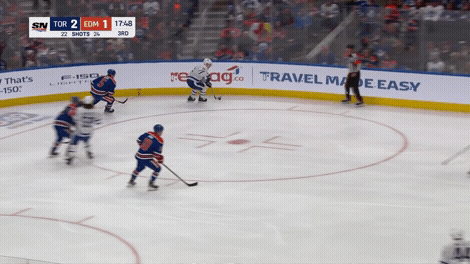
It starts with exactly what I’m talking about: Max Domi having the puck in solid possession here:
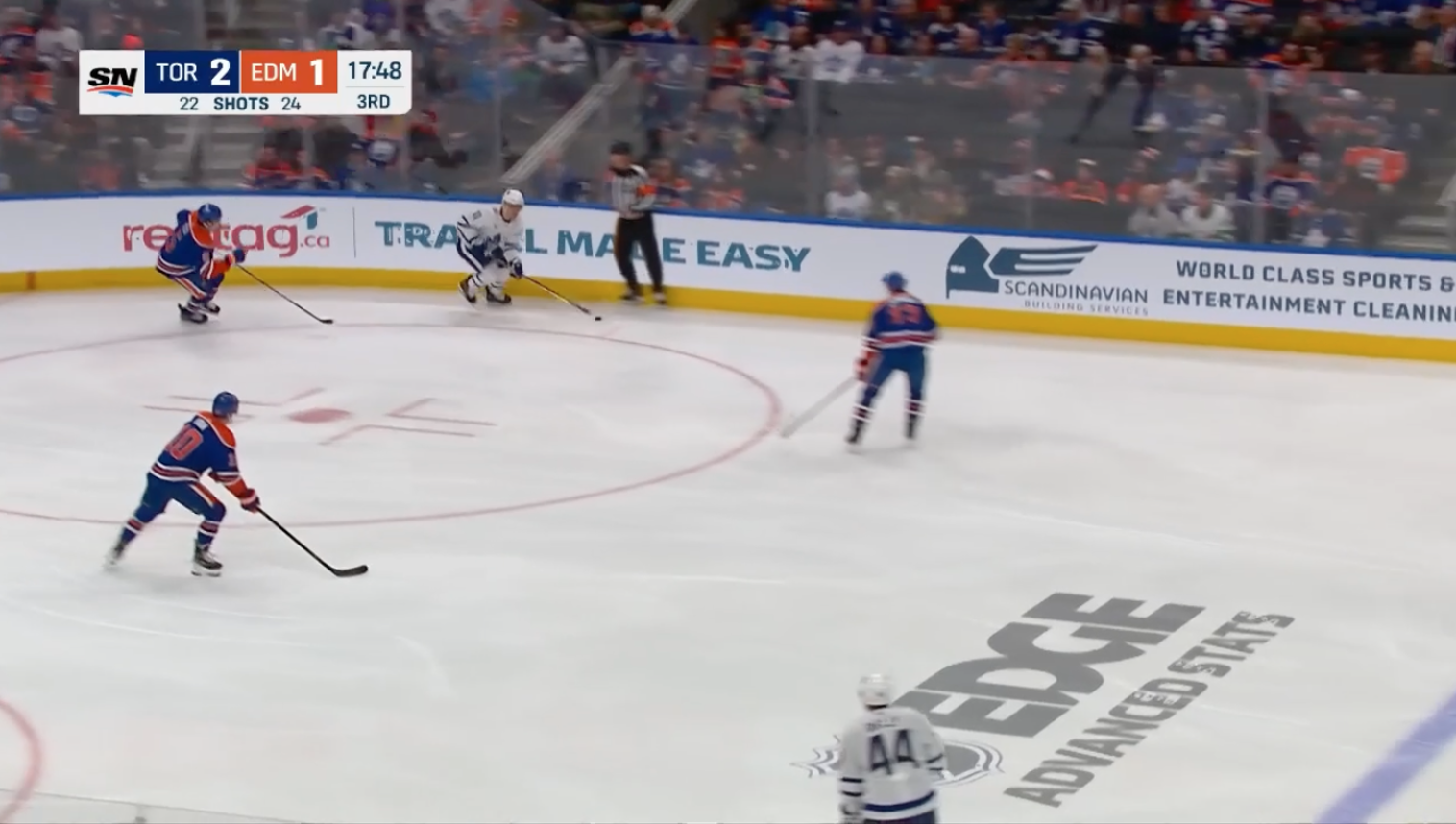
Once the cross-ice play to Rielly closes off, Domi can either find a way to get it to the defenceman on his own side of the ice (a riskier play with his linemates deep), or just bump it back in the corner for Tyler Bertuzzi to skate on to. They’re the third line, the team is up a goal, and on the road. That would’ve been the play.
But instead Domi spins and tries to sift one into the slot.
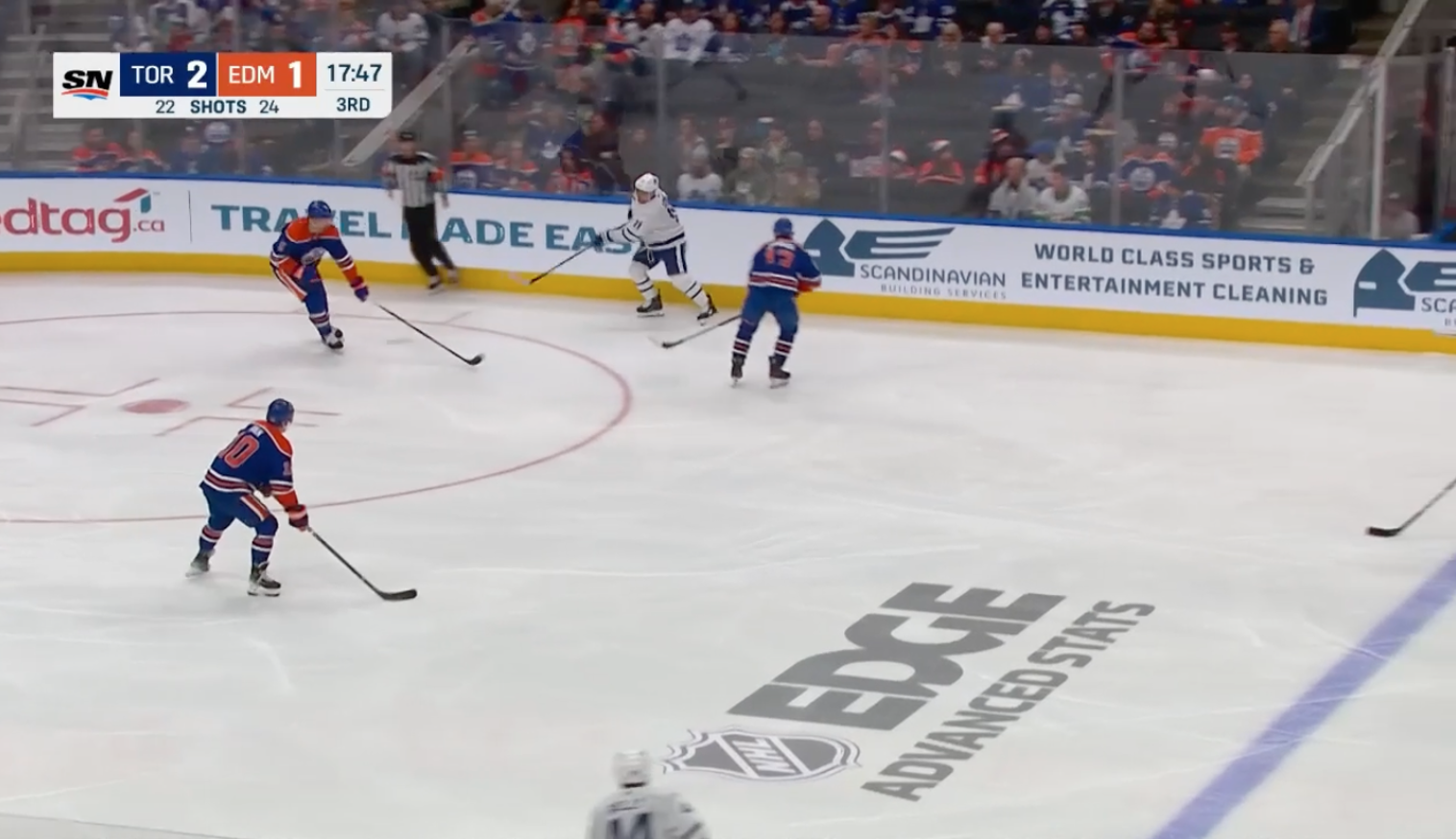
It doesn’t get through. Rather, it hits the skate of an Oiler and careens off to the far boards.
Now, I mentioned I wanted to use this goal to go big picture and this is the kind of play I’m talking about. Domi is culprit 1A of the Leafs' forwards. There’s about 10 of these from the Leafs' four-game losing streak, but the Detroit game was especially bad. Here’s a quick 30 seconds showing five forced O-zone attempts from Domi over the past couple games:
Yes, he makes some great passes. But he also tries a ton of questionable passes, so you’d expect at least some to work out.
But back to the play on Edmonton's tying goal Tuesday. Oilers forward Ryan McLeod is skating on to the puck, so Matthew Knies' mindset should switch immediately to defence, and coming back in a straight line.
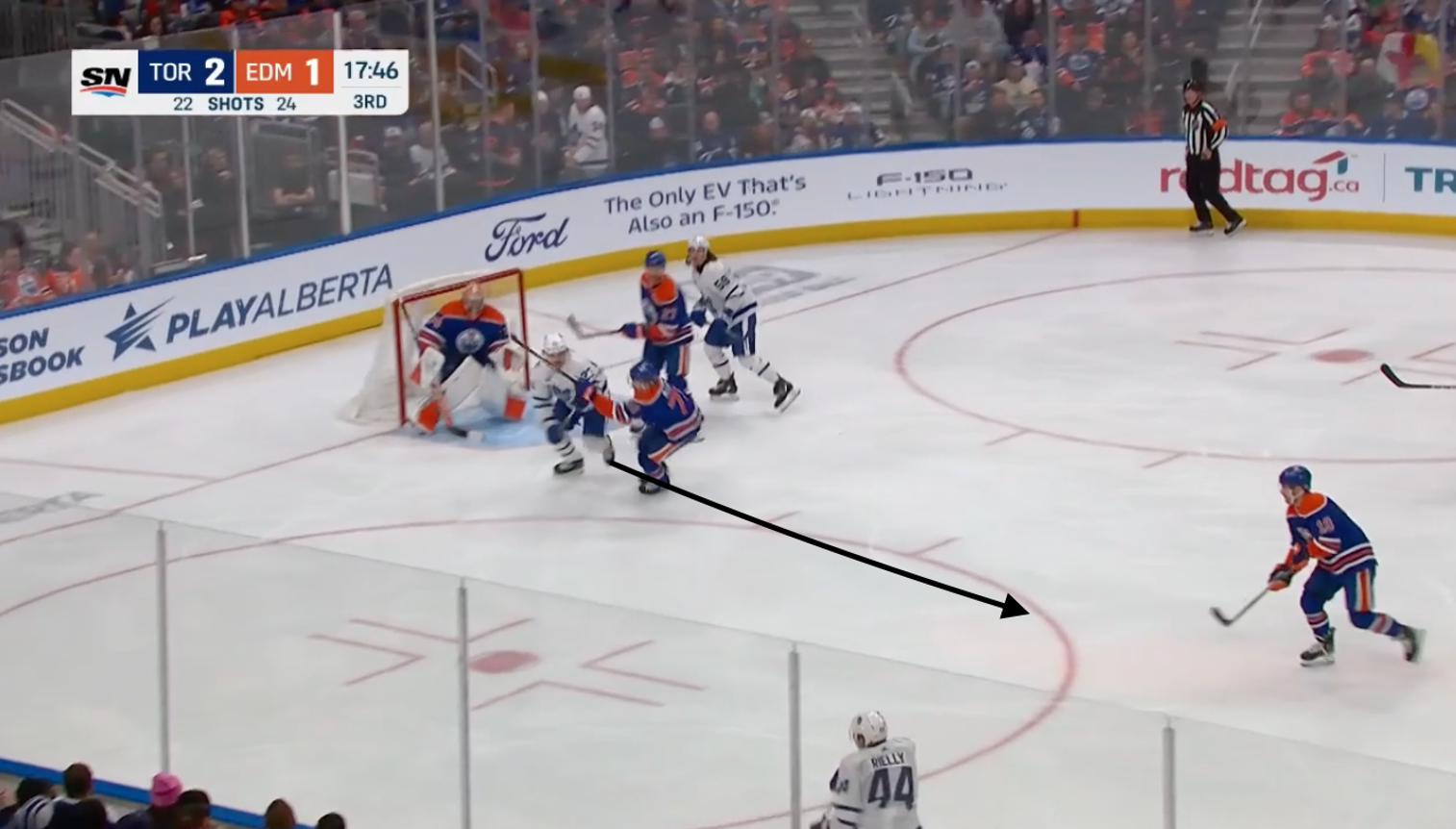
But he skates along with McLeod after the puck, gets underneath that battle, and ends up chasing the play.
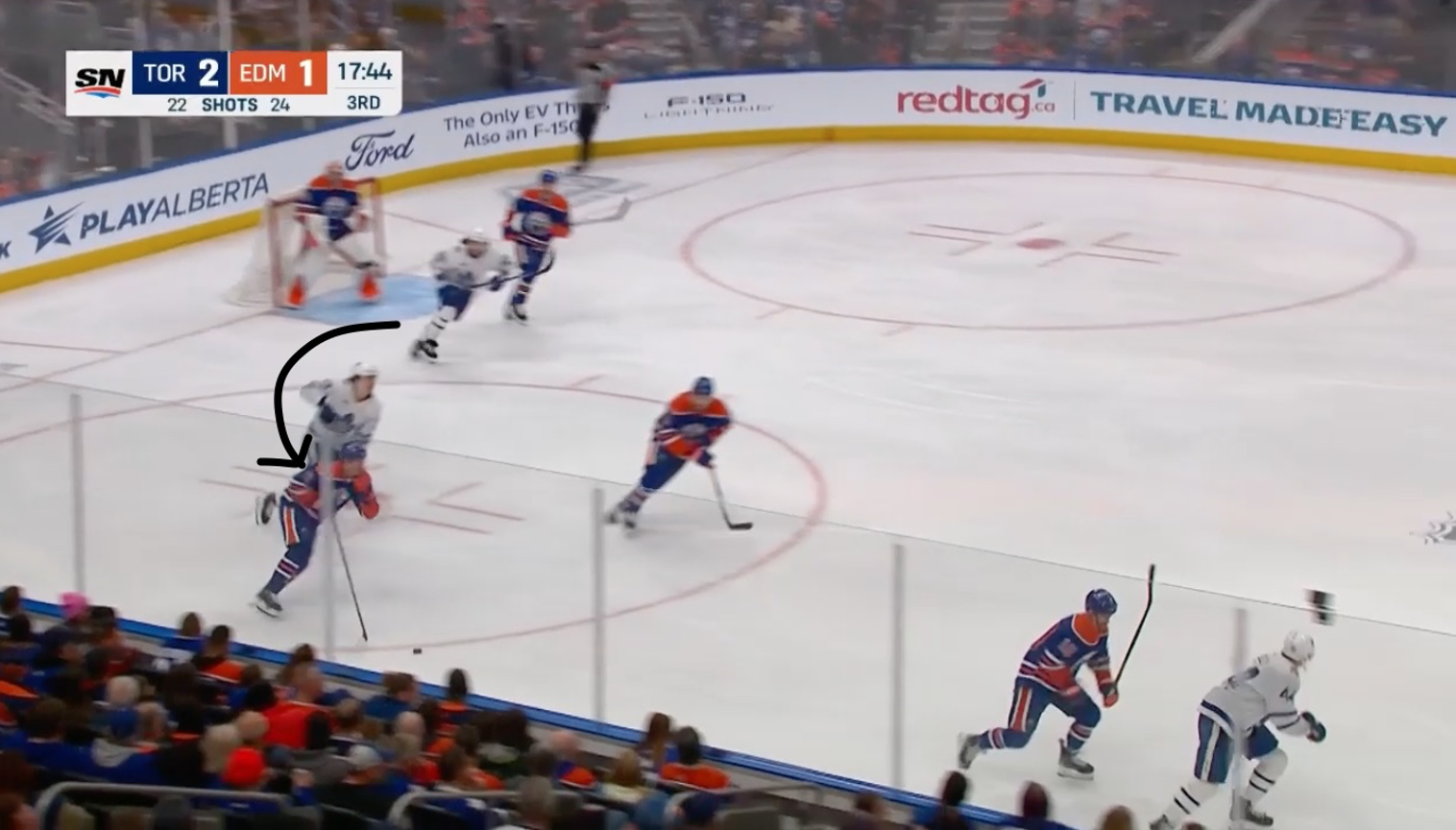
While Knies puts his head down to get back, Domi has done the right thing after turning it over – he’s pulled out to centre to get into a neutral zone forechecking position in the middle of the ice. He could pivot and skate backwards with the rush, or skate forwards and lock on to a guy, or at least establish a lane he’s going to take from his position in the middle of the ice.
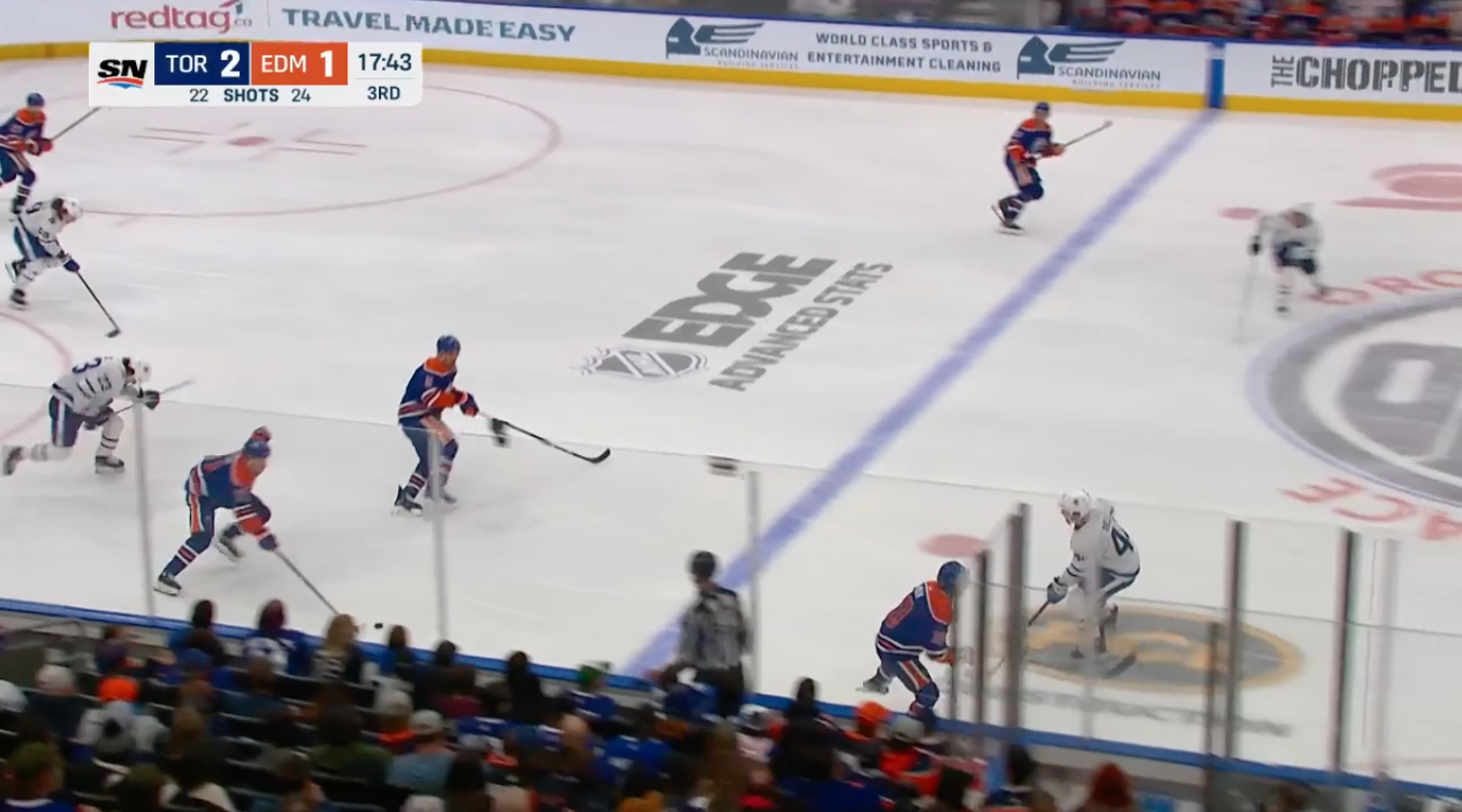
Instead, he decides to go for a steal, which McLeod reads.
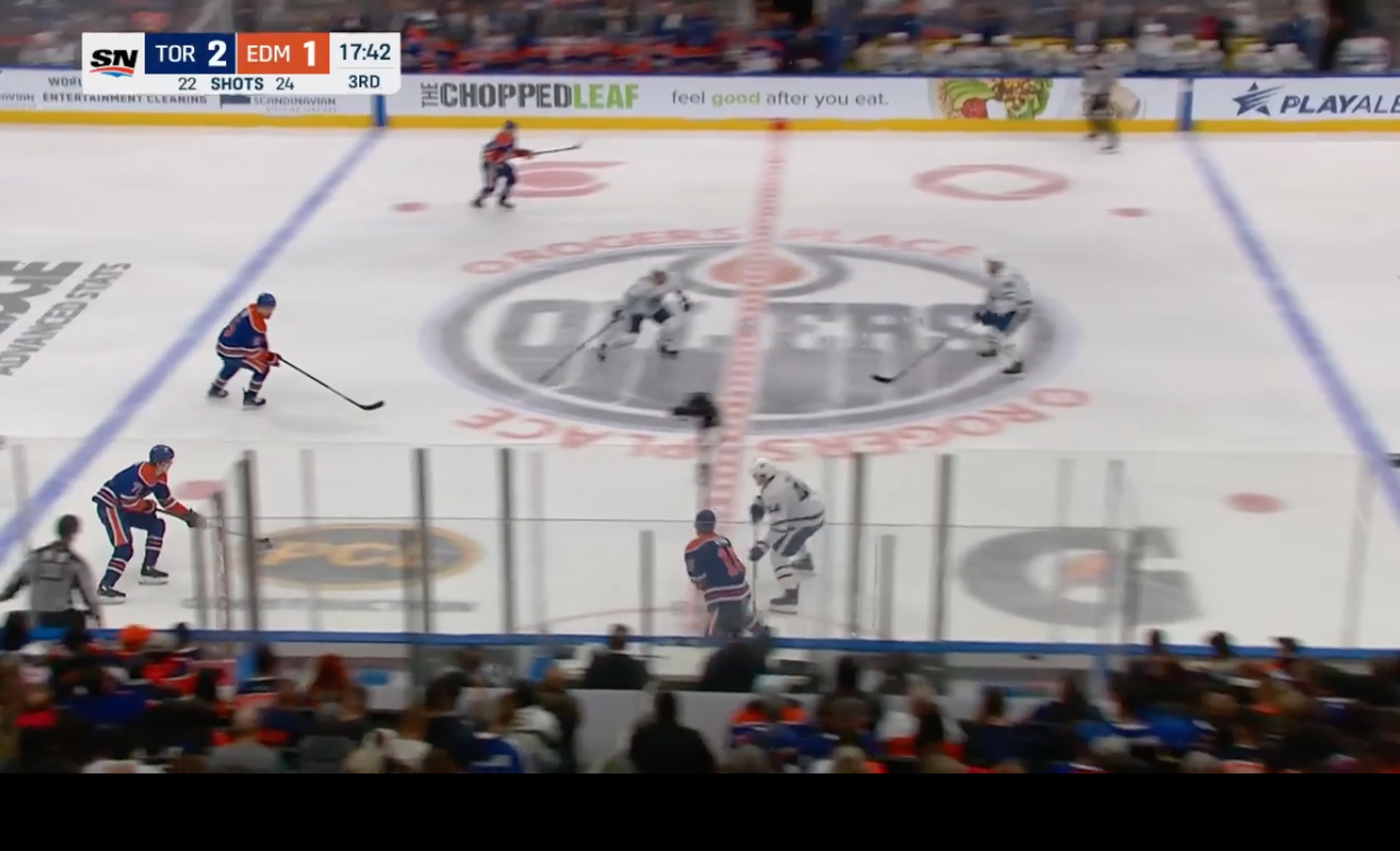
And Domi takes himself out of the play:
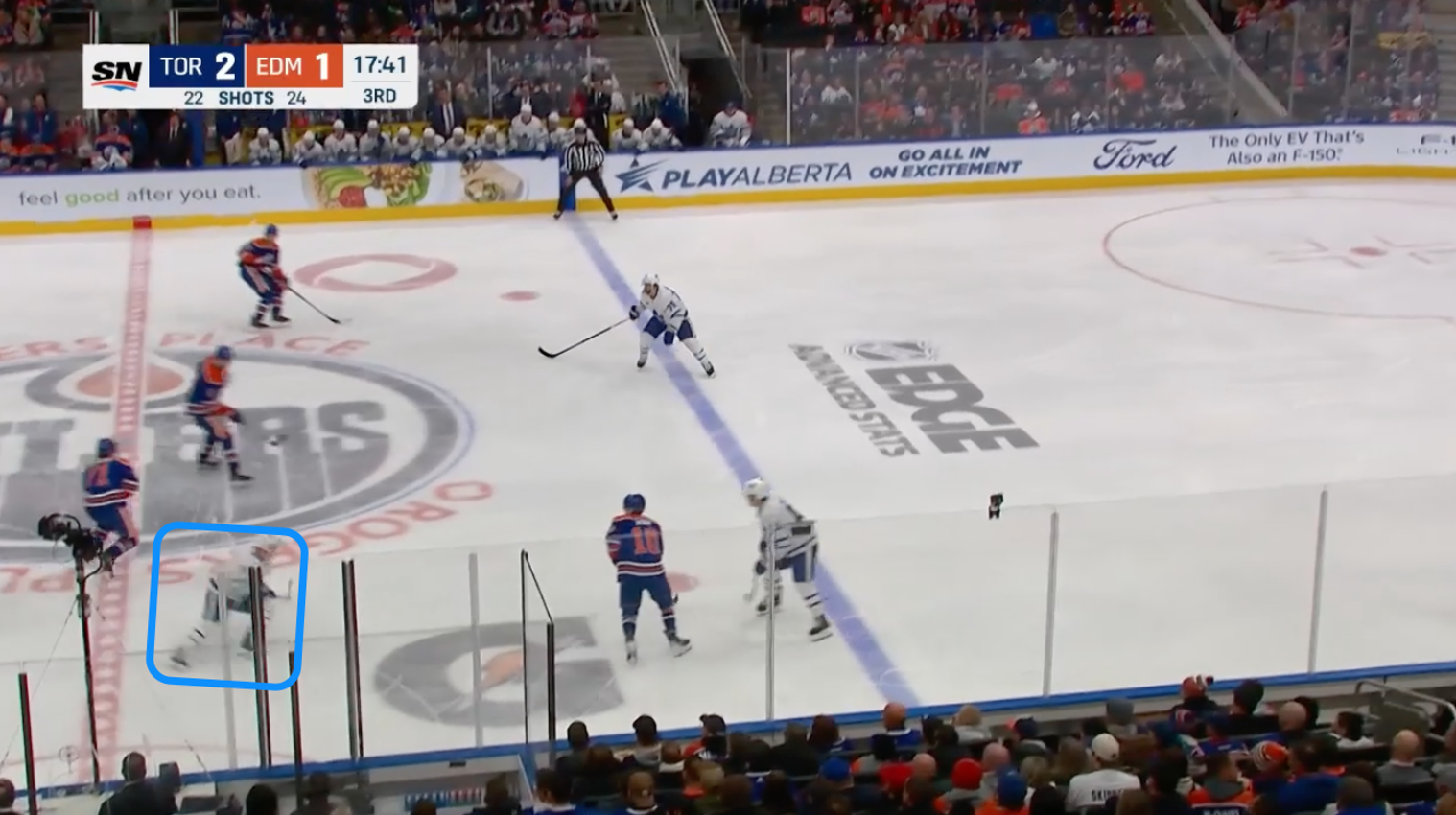
At this point McLeod kicks it out to Mattias Janmark, and drives through the middle (good fundamentals by McLeod). In the below shot, Knies has managed to be the first forward back (which is how you determine who is going to play low), but he may be a little confused because Domi was originally the first forward back until he got beat in the neutral zone. Either way, Knies is underneath the eventual goal scorer here, and should just carry on being the low forward.
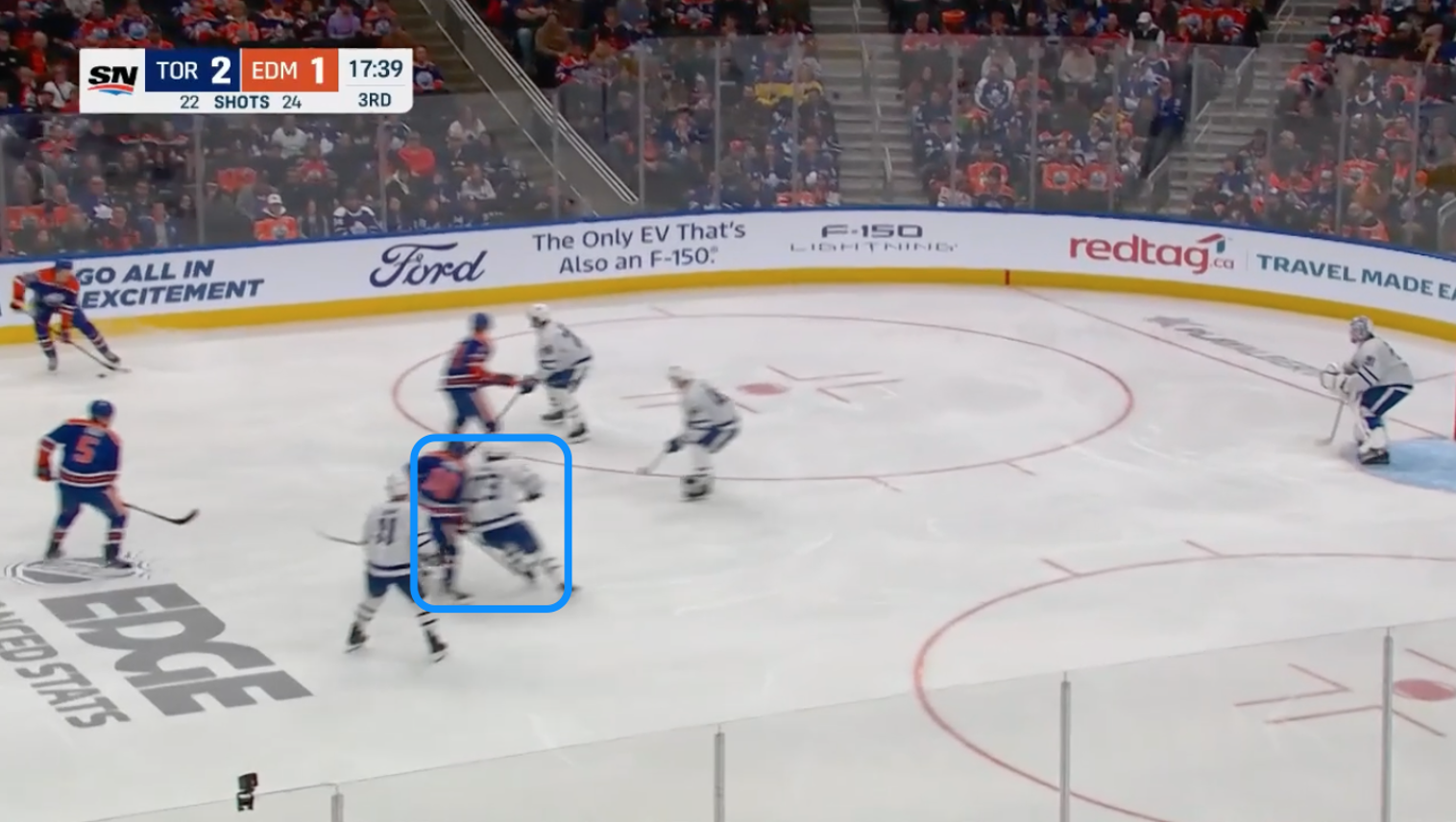
Had he done that, Rielly could pick up McLeod going through, Knies would have Derek Ryan, and TJ Brodie could go front the puck. But with Knies being a winger, and Domi not exactly being a natural centre, both guys get fixated on the puck (Domi could’ve read off Knies and kept coming back, too), and suddenly there are way too many unmarked Oilers down low.
The next season-long issue is…TJ Brodie.
With three Leafs forwards fixated on the puck, he probably could have dropped back here and let someone else handle the “this guy is definitely not shooting that” fake from Janmark. Look at all the Leafs forwards staring at the puck here:
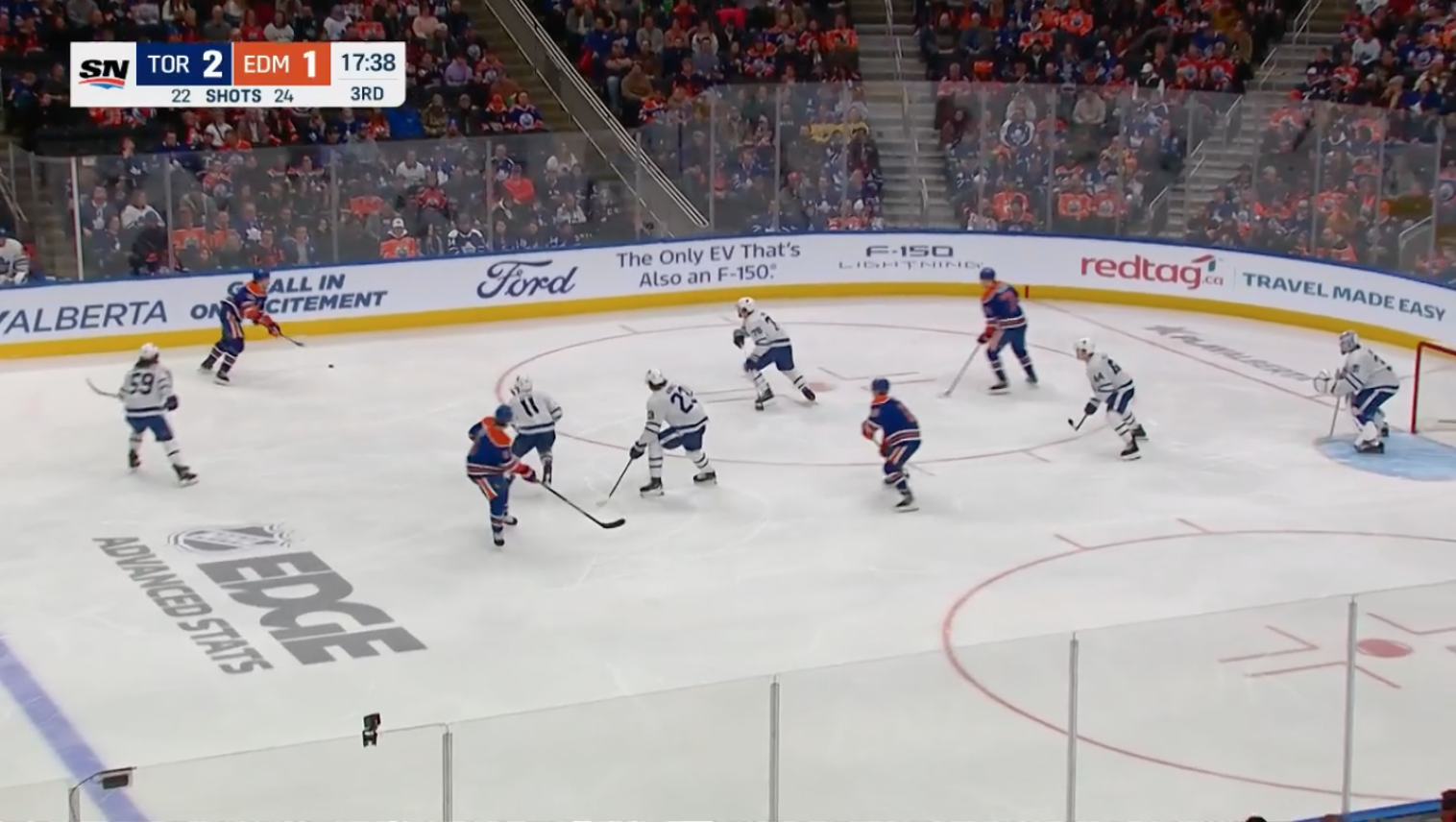
The next image here is, to me, "emergency time" and Brodie should sprint back to help, but he’s strangely casual in his retreat.
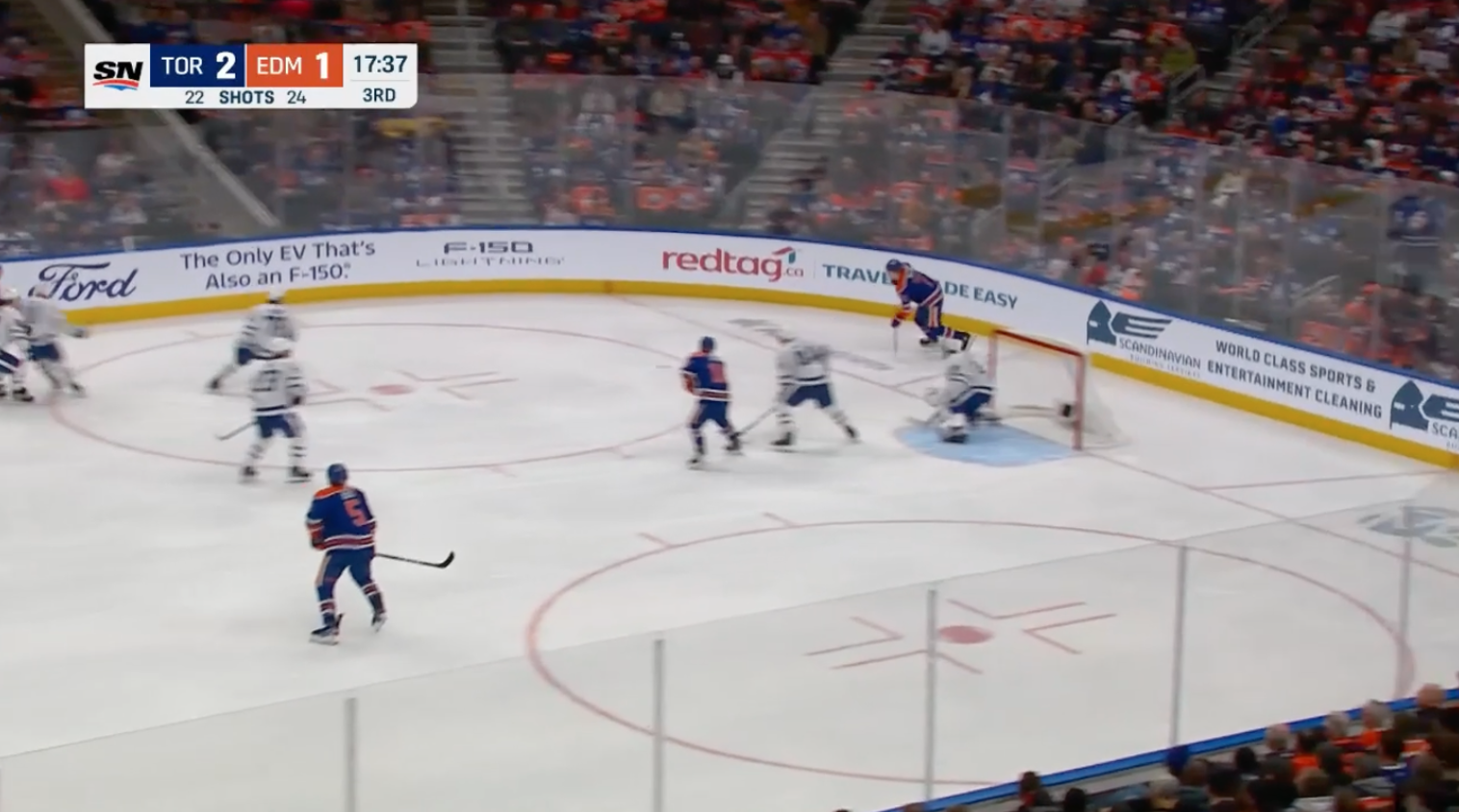
Knies could certainly have gotten back into “help” defence, given Brodie is so far away. And, actually, Knies does get back in time, he just feels that as the winger the opposing defenceman (Cody Ceci) is his guy. But, a personal coaching rule of mine is to scrap all coaching rules when someone is open in front of the net and just take them until further notice.
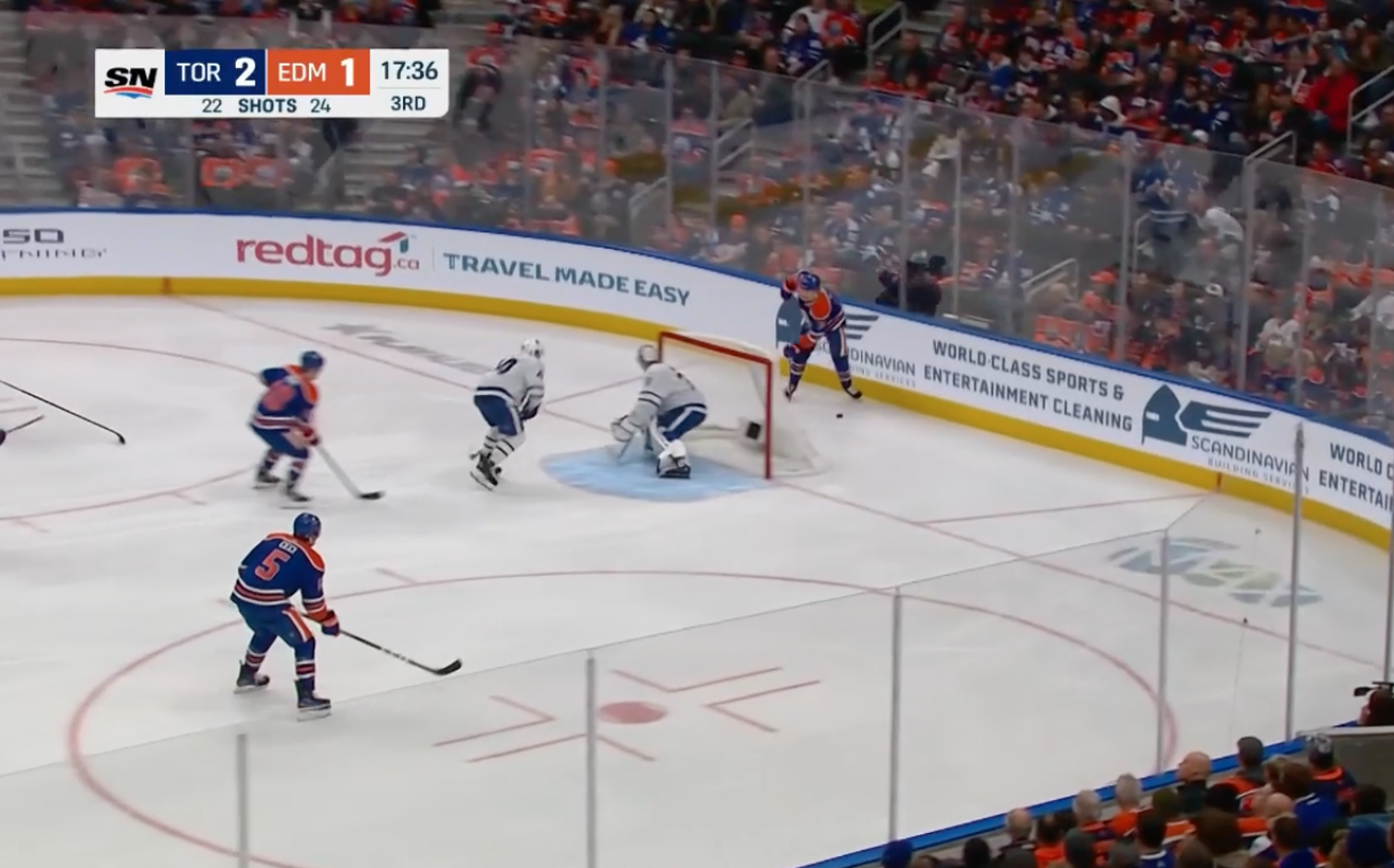
Brodie is too slow making the read.
As has been discussed, Brodie is supposed to be the Leafs' second-best defenceman, but he is having a tough time.
It was Brodie who Zach Hyman undressed on the disallowed goal. If you watch the Oilers' chances from Tuesday night, Brodie's generally standing beside the guy shooting it. And this trend of getting beat is happening even with something I’ve written about before, that Brodie's gap distances have gotten worse to avoid getting cooked wide.
Toronto probably needs two defencemen, so sending Brodie out in any trade doesn't help you. In sum, Brodie is a problem that needs solving for the Leafs to have real post-season success, because he’s going to be on the roster.
If we jump back to Tuesday's game now, Brodie’s too slow getting back to Ryan, barely in the frame on the right here…
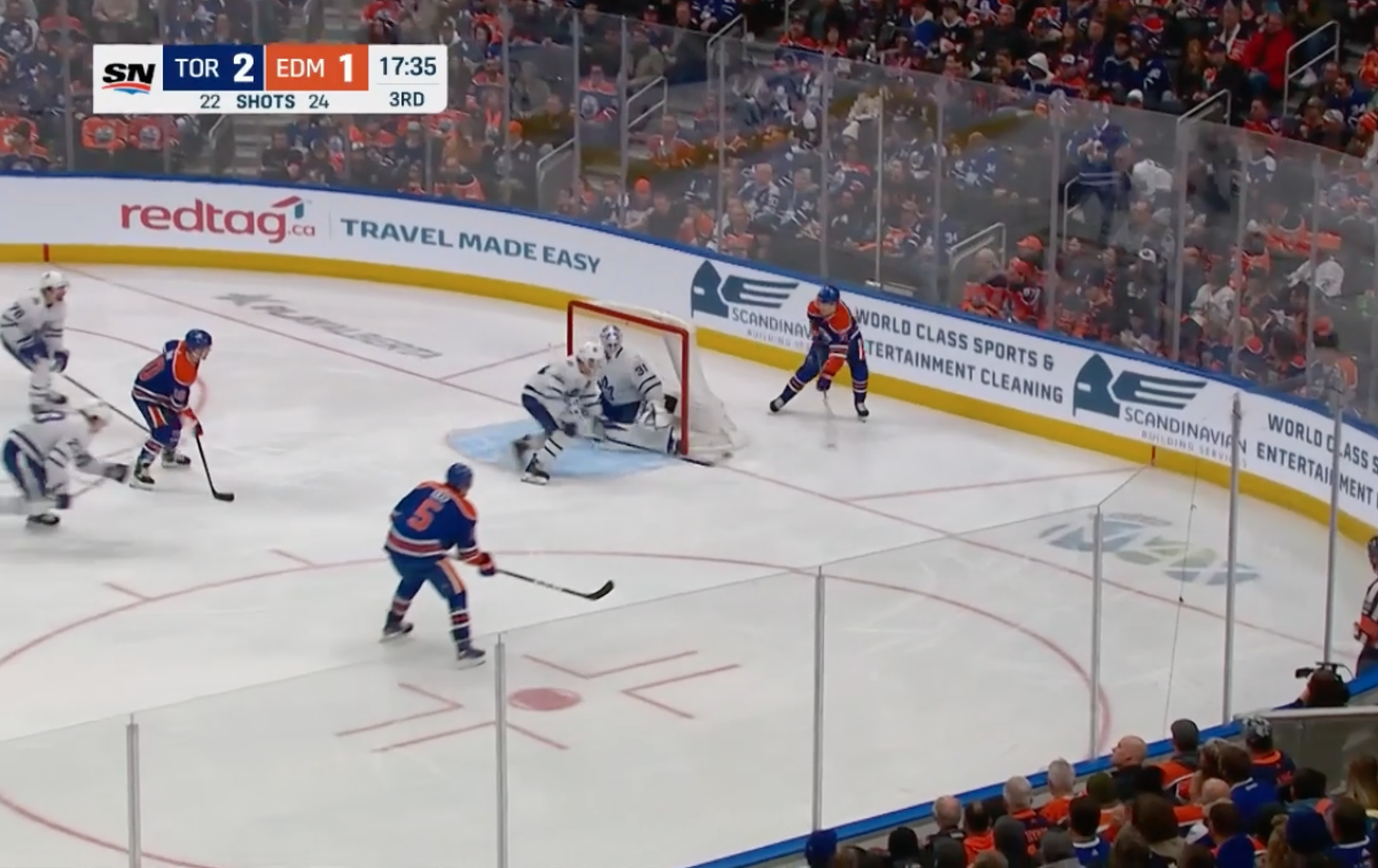
And with Knies going to cover Ceci…
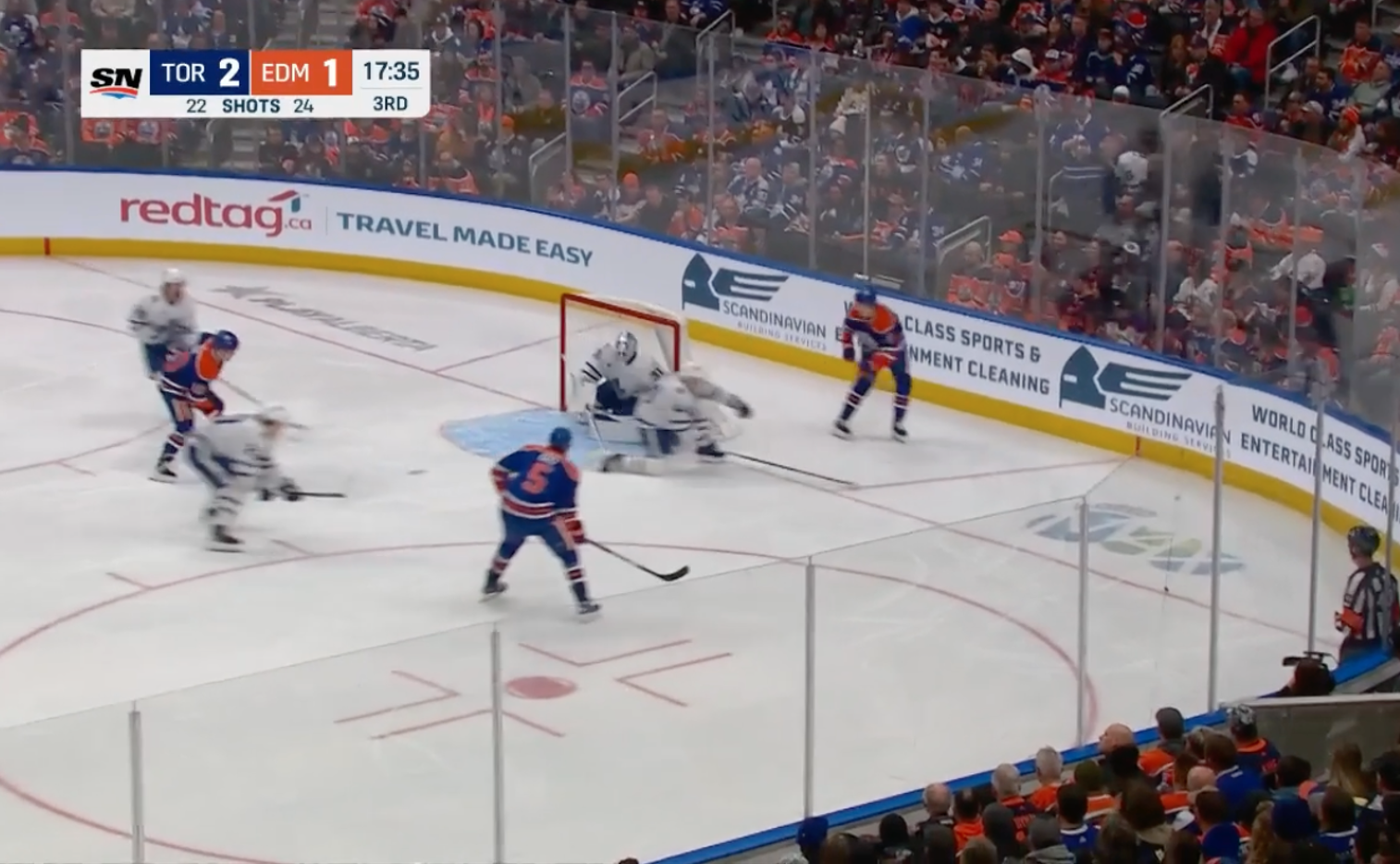
That’s all she wrote...
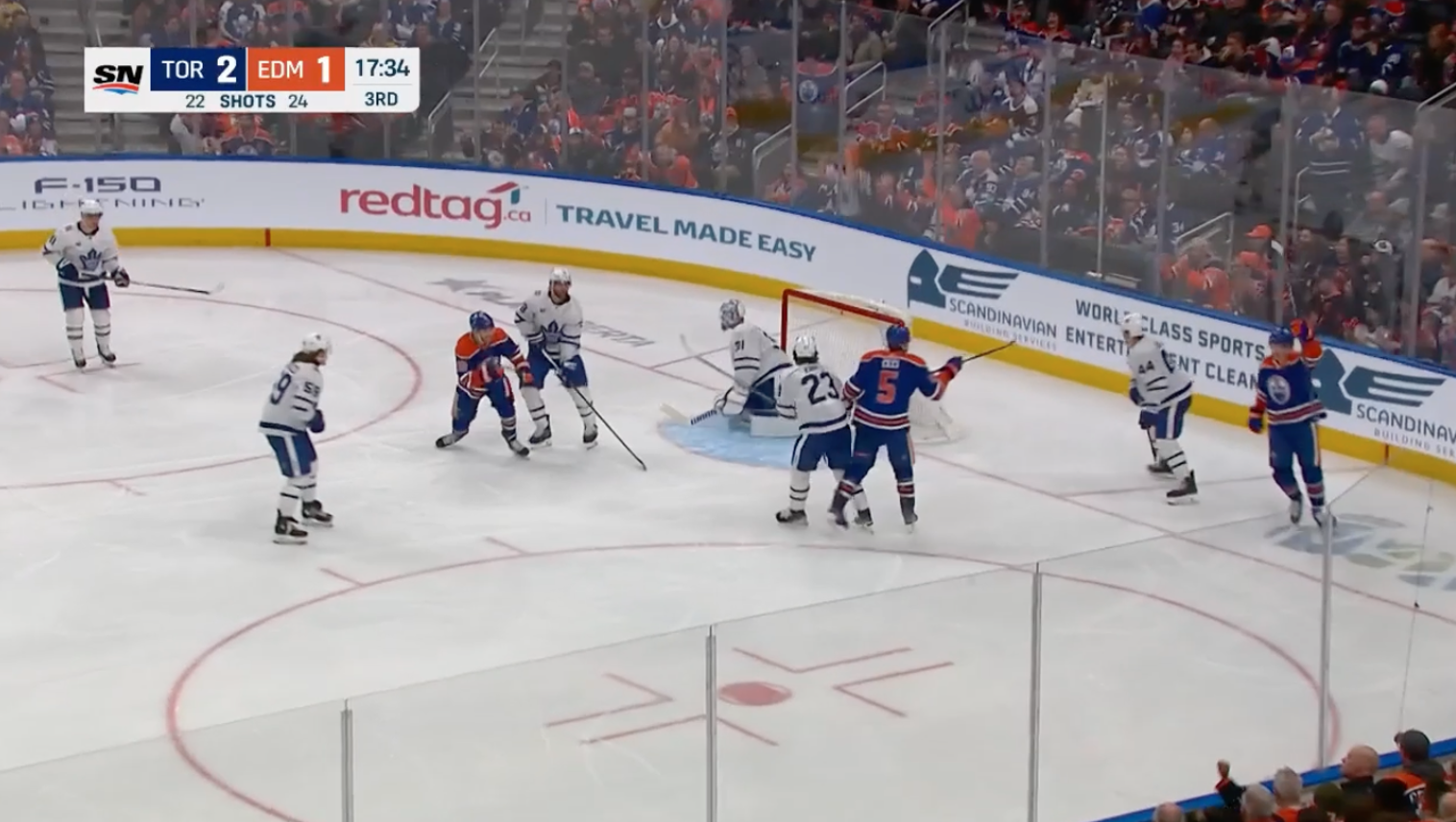
That goal made the game 2-2, which brings me to my final point about Toronto's struggles: they’ve absolute stopped playing when they’ve had the lead, hoping to hang on (yet not, ironically, holding on to the puck).
Using SportLogiq’s chance data, the Leafs actually had more Grade A chances than the Oilers in the game and, having watched it, I’d subjectively say that’s fair. The Oilers had far more total chances though (way more Grade B and Grade C chances), and a big part of that is the Leafs just…stopped creating offence entirely once they got a lead. Looking at it by period, Toronto had six chances in the first, seven in the second, and one in the third (a David Kampf rush).
If you don’t love the makeup of your defence corps, saying “that should do it” for goals when up by just two can be costly.
The Leafs are saying they’re not unhappy with how they’ve been playing. And they haven't been getting shelled in the games they've lost recently, so maybe that's fair.
But I think fans have seen some of Toronto's biggest flaws get exposed recently (struggling defence and O-zone turnovers), and are frustrated at the reality that the roster needs help and also that the coaching staff can do more.
It’s never as simple as one thing, and there’s no quick fix for legitimate roster problems that the Leafs have. Until Brad Treliving makes changes, the rest will fall on Keefe and the players to sort out, or they’re in for a long cross-Canada road trip over the rest of the week.






